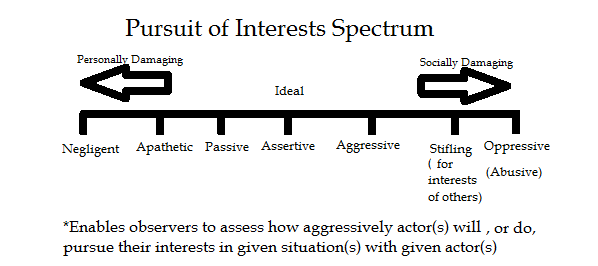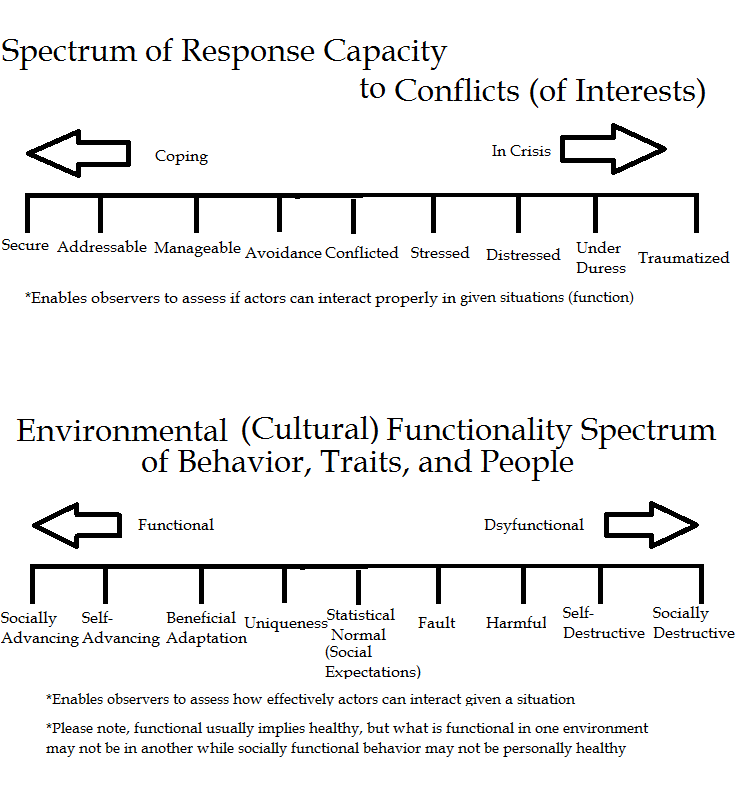|
Ideally, actors (nonhuman living creatures, people, groups of people, social institutions, businesses, states, etc.) will pursue their perceived interests, which might include their short-term, long-term, and/or indirect interests, in an assertive manner, thereby enabling the interests of all actors to be adequately addressed when conflicts of interest arise. In the real world, overly aggressive actors tend to stifle the interests of more passive actors while individual actors respond differently to different actors. In fact, some manipulate actors, who are focused solely on their own interests, will undermine other actors attempting to be assertive by claiming the actions of others are stifling or abusive. Meanwhile, passive actors will often perceive assertive actors as being overly aggressive, because they tend to neglect their own interests, and assertive actors are inclined to ignore the interests of passive actors. Obviously, this type of dynamic creates a problem as it hinders actors from reaching a point of equilibrium in their interactions, i.e. society starts to malfunction. Psychologists, sociologists, economists, and political scientists chart information in order to clarify what their data might be telling them. By viewing information as a spectrum chart, which presents a particular component in terms of an increasing prominence or intensity toward two opposing extremes, individuals can look at how actors interact with similarly treated actors over time to assess whether individual actors are properly pursuing their interests, which can vary for different types of interests and different actor traits. (Please, be aware that this type of modeling is highly dependent upon the observer’s working definition of the descriptors used, so what words are used to describe a trait can be put in a different order while each descriptor can be broken down into subcategories; the objective of using the spectrum chart is to demonstrate an increasing tendency toward one extreme or the other.) The ability and the capacity of actors to pursue their interests help determine the health of every aspect of our society. As such, here are two more spectrum charts that are useful in understanding whether or not actors are functioning properly in our society. Meanwhile, the balance of leverage among actors plays a major role in determining if the interests of all actors can and will be pursued (external/socially mitigating factors).
(See Yahoo! Contributor article for additional information: http://voices.yahoo.com/the-greater-economic-leverage-12069168.html?cat=3) Conversely, the tolerances of every actor for various necessary discomforts also play a major role in determining if the interests of the actors can and will be pursued (internal/personal mitigating factors. (See Yahoo! Contributor article for additional information: http://voices.yahoo.com/the-role-substitution-decision-making-12201011.html?cat=72) Why these spectrum charts and other models are useful: Intellectual pursuits are about breaking down complex systems into manageable, comprehendible components, so we can better understand our world. Just as three dimensional objects can be mapped into two dimensional components, so can the many aspects of the human mind, such as emotions, and the interworkings of nonhuman actors. That said, it is often difficult to recognize the two dimensional map as a representation of the three dimensional object, especially when the observer lacks the intellectual tools and architecture needed to fully understand the representation, while the 2D map needs to be larger to account for all of the 3D data. As such, these charts help describe one component of how the human mind and social actors function. A few more thoughts that can be useful when trying to understand and model the dimensions of the human mind and actors, which behave like humans: (Derived and adapted from Carl Jung’s theory of personality) Personality is constructed of the Psyche(Self), Ego (modes of thought), Persona(s) (modes of behavior), Shadow(s) (suppressed modes of thought and behavior), and Essence (soul) Self-Ego = Essence Ego-Persona = Shadow ;therefore, Self-Shadow-Persona = Essence Personality Modes = modes of thought (mindset, worldview, perspective, etc…a.k.a the training and others experiences actors use to acquire, process, and apply new information) + modes of behavior (See Yahoo! Contributor article for additional information: http://voices.yahoo.com/describing-mind-as-modes-thought-12154416.html?cat=72) Categories of Modes of thought Environmentally Determined: Social, Cultural, Communal, Familial, etc Mentally (internally) Determined: Psychological, Intellectual, Emotional *Assess if modes are Egocentric (subjective) versus Transcendent (objective), subjective nullifying (ignore bias), subjective bridging (identify common views), subjective compensating (compensate for bias), to determine how to properly interact with actors acting in a particular mode. Categories of Modes of behavior Instincts (type of response): Intellectual, Intuitive, Emotional Motivations (responsiveness to types of stimulus): Economical, Social, Emotional *Assess if responses are socially and personally regressive versus progressive, degenerative versus constructive, functional versus dysfunctional, etc (See Yahoo! Contributor article for additional information http://voices.yahoo.com/defense-against-dark-arts-manipulators-12135042.html?cat=41) Personality (Identity)Disorders: Persona Disorders: social environment distorts expression of true self Shadow Disorders: social environment suppresses true self Essence Disorders: philosophically conflicted (conflicts of interest over morals and ethics, spiritual disharmony, etc.) Types of dysfunctions Social(culturally maladapted), emotional, identity, behavioral (impulse, addressable with retraining, versus thoughtful action, addressable with reeducation), trauma-induced, etc. (See Yahoo! Contributor article for additional information http://voices.yahoo.com/trying-understand-ptsd-other-trauma-induced-12225670.html?cat=72) *Assess to what degree dysfunctions are manifested internally versus externally and if they are the result of situational factors versus personal factors (biology, personal history, etc.) A note on the scientific method, circular reasoning, deductive/inductive reasoning, and subjective/objective thinking: Subjective beings with limited comprehension of the universe must use specific examples to derive generalities in order to function. After all, relying on generalities to understand how to react to specific situations would prevent humans from responding to real world events in real time. It is, in fact, our subjective nature that results from our need to use inductive reasoning. Therefore, subject beings, who are trained to address various situations in an objective manner by transcending their bias (scientists), versus those trained to find common ties in order to bridge subjective perspectives (philosophers), with limited knowledge of the universe, use both inductive and deductive reasoning. Inductive reasoning allows us to develop generalized models that can be used to deduce specific predictions. Inductive reasoning may well be the inverse of deductive reasoning, yet inductive reasoning is verified by deductive reasoning. This is not circular reasoning as different examples are used to induce a generalized model before those examples are used to deductively confirm the generalized model. In essence, this is the scientific method. Saying God exists because God exists is circular; however, deriving the existence of God from events and circumstances is an example of unverified inductive reasoning. Proper examples of God’s actions would be needed to use deductive reasoning to confirm His existence. These proper examples may or may not exist, i.e. the theory may not be testable, which is why religion is not scientific in nature. As such, the question of whether God exists or not is not a scientific question, because it is not testable. It is a philosophical question. It is not, however, circular reasoning; God is an idea derived from a subjective perspective that utilized inductive reasoning to arrive at the conclusion that God exists. That said, it is only from an objective, non-religious perspective that this line of reasoning can be used as this particular subjective perspective has evolved to exclude the possibility that God does not exist. Again, this is not circular reasoning as the subjective perspective would cease to exist if another conclusion was reached when it is transformed into a different subjective perspective. *Religion is a philosophy based on a shared belief of the unknown.
Comments
|
Read old posts
April 2020
|



 RSS Feed
RSS Feed
